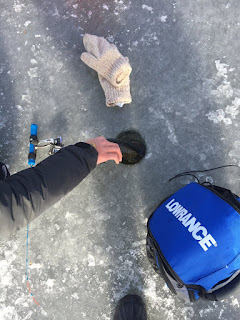Early Spring Bluegill Fishing
This past week, warming water temperatures signaled the beginning of the open-water fishing season. I took a trip to Muscoot Reservoir to catch bluegill; initially, I was concerned that I had come too early in the season and that the fish would be lethargic from the fleeting winter, but thankfully the bluegill were hungry and willing to bite.
Immediately after the bait was properly positioned over the weed-line, the fish bit almost immediately. Their willingness to bite could be attributed to the cloudy day and the 60 degree air temperatures. We fished for about three hours, starting around 3:00 in the afternoon to around sunset, and we were able to catch almost forty bluegill, with most being around six to eight inches. Muscoot reservoir has a lot of smaller sized bluegill, which could be avoided by using a small plastic minnow imitation bait instead of a wax-worm because smaller bluegill would have a hard time fitting the larger profile plastic into their mouths. Additionally, smaller bluegill would be hesitant to pursue large quarry like minnows, opting instead for aquatic insects.
I targeted these fish in a small cove off the main lake. I used a bobber with a small jighead suspended a foot off the bottom over a shallow weed-line in about four feet of water. On the jighead, I was using two or three waxworms, which I threaded on the hook. On this day, the fish were associating very closely with the weeds, so it was very important that I was able to cast at least 40 feet from shore where the weed-line started. To do this, I used a weighted bobber, which was easy to cast and cut through the mild crosswind.
 |
| Note the vertical stripes on this bluegill, which indicates that it spends a lot of time in and around weeds |
Immediately after the bait was properly positioned over the weed-line, the fish bit almost immediately. Their willingness to bite could be attributed to the cloudy day and the 60 degree air temperatures. We fished for about three hours, starting around 3:00 in the afternoon to around sunset, and we were able to catch almost forty bluegill, with most being around six to eight inches. Muscoot reservoir has a lot of smaller sized bluegill, which could be avoided by using a small plastic minnow imitation bait instead of a wax-worm because smaller bluegill would have a hard time fitting the larger profile plastic into their mouths. Additionally, smaller bluegill would be hesitant to pursue large quarry like minnows, opting instead for aquatic insects.
 |
| A nice bluegill |
Paramount to our fishing success was the line that we were using: 4lb P-Line Fluoclear. P-line Fluoroclear is a polymer that is half fluorocarbon and half monofilament, so it is affordable, sufficiently strong, and also hard to detect under-water. P-line combines the positive attributes of both fluorocarbon and monofilament. The strength of P-line allowed us to use 4lb test line with relatively heavy bobbers. It is important to use a small-diameter line when fishing for bluegill in cooler water because they can be more line-shy.
We used an ultralight spinning rod and reel setup: Fenwick Eagle 7'6'' UL rod and a Shimano Sienna 2000. The long rod allowed us to cast far through the crosswind. Additionally, the long rod made hook-sets easier because we were able to sweep up slack line accumulated on the water. If possible, however, I would have preferred a faster action rod than the Fenwick Eagle just because hook-sets more firm.
Here are links to the equipment that we used on FishUSA.
Thanks for reading!
- Paul 3.29.20


Comments
Post a Comment